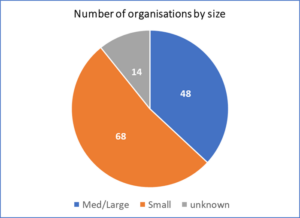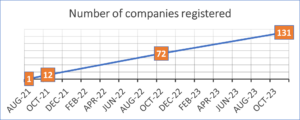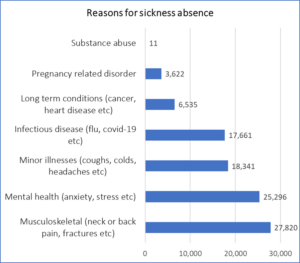Wellbeing at Work: Year 2 Evaluation Summary (2022 – 2023)
The Wellbeing at Work programme enters year three of delivery, how time flies!
Since the launch of the programme in 2021, there have been 139 East Sussex employers register their interest. 64 of those have seen their achievements recognised with an award: Commitment – 24, Bronze – 30, Silver 8, Gold 2. A big congratulations to those awarded employers and a message of encouragement to those striving towards accreditation.
The programme is unique in that it has been independently evaluated since its inception by Mike Parker from Progress Health Partnerships, and Nick Cavill from Cavill Associates. The programme released its first evaluation report in December 2022, covering October 2021 to October 2022. A process evaluation design was used to understand why the intervention was successful or not in achieving its aims and objectives. Also, for whom the programme works best for by providing insight into aspects of the intervention that might need changing or developing. At the time of the first evaluation, there were 72 organisations registered, reaching over 7,000 employees. Year one gave the Wellbeing at Work team great confidence that employers benefitted and enjoyed the process. It was recommended to ‘continue the good work!’.
So, that’s what we did. Programme Coordinator, Sarah Nash and Project Officer, Flavia De Melo Dewey, followed later in 2023 by new programme coordinator Matt Ellis and Georgie Chesman, Project Officer, continued the fantastic work. The team built upon the foundations set by almost doubling the number of registered organisations in year two. The evaluation focuses from November 2022 – November 2023 and the process remained largely the same. 68 organisations provided data (17,915 employees, 72% female, 52% aged over 44 years, 70% classified as ‘White British’ – lower than the local population, 92%). Below is a summary of the year two evaluation findings and recommendations.
Evaluation Aim
To understand the extent to which the programme has achieved its intended outputs and outcomes (please see East Sussex Wellbeing at Work Accreditation Programme – Independent Evaluation Report Year 2 for full list of intended outputs and outcomes) and explore the factors that influenced this.
Evaluation Objectives
- To critically appraise and advise on the process of developing and implementing the programme
- To gather the views and opinions of stakeholders, employers and employees involved in the programme
- To gather and analyse programme level data, to include as a minimum output data, short-term impact data and medium-term outcome data
- To draft and then finalise an annual evaluation report with key findings that address the main questions of the evaluation and draw clear recommendations based on objective findings of the research
Evaluation design included the following activities
- Programme stakeholder survey: Stakeholders involved in the development of the programme
- Participating workplace survey: All workplaces that had registered and progressed
- Non-participants workplace survey: All workplaces that had registered interest but had not progressed
- Employee survey: Employers progressing on the programme were asked to send a survey link to all their employees
- Semi-structured interviews: With 14 selected stakeholders and employers
- Mental Wellbeing at Work Deep Dive: Exploring the high levels of sickness absence because of mental ill-health
Finding Summary
- The design and implementation of the programme has followed best available evidence and good practice and has benefited from co-production between employers, employees, and external stakeholders
- Despite very limited resources, over 130 organisations have registered onto the programme during the first two years and these registrations have continued at the same rate in year two as in in year one
- There is evidence that the programme has led to improved knowledge and understanding of the health and wellbeing issues that they can help to influence and support
- Across the two years (based on 59 organisations) over 100 new health and wellbeing policies have been developed, most notably in relation to the two areas of greatest concern – mental health and wellbeing and musculoskeletal health
Findings
Registered Organisations
- 131 organisations registered (Nov 2023)
- 52% are micro/small organisations
- Just 5% have withdrawn from the programme


Registered Organisations (sector)
- 52% private sector
- 22% public sector
- 27% third sector
- Top three: 32 charities, 17 healthcare, 12 care home
Accreditation
- Significant growth in year two
- 53 organisations (cumulative) have received an award (increasing from seven in year one)
- First two Gold Award organisations (Servomex – Large Business. Affinity Select Insurance – Small Business)
Reasons for registering
- Most important – Follow a framework to improve workplace wellbeing
- Least important – Network with like-minded businesses
Topics of interest
- Most important – Mental Health & Mental Wellbeing
- Least important – Alcohol, substance misuse and stop smoking
Sickness absence data
- 42 organisations provided anonymised (combined/not individual) employee sickness absence data over a 12-month period.
- 156,910 combined sickness absence days (based on 12,305 employees).
- Average sickness absence ranged from a low of 0 days to a high of 17.8 days.
- Average number of sick days per employee was 4.6, mirroring the UK average.
- 38% of organisations had an average employee sickness absence rate higher than the national average.
- Large companies had the highest levels (14.14 per employee)
- Micro companies had the lowest levels (1.86 per employee).
- MSK and mental health are the biggest contributors to sickness absence in large and medium size companies.
- Minor illness and infectious disease the most significant contributors in small and micro companies

Organisational impact
- A total of 111 new/updated health and wellbeing policies have been introduced because of this programme
- Mental Health and Mental Wellbeing were the most common (27)
Employee perspectives
- 139 employees from 16 organisations completed the survey
- Represented 27% of organisations registered in 2022
- Represented 35% of employees from those 16 companies
- Mental health and wellbeing are the most important health and lifestyle issue to employees
- 71% of survey respondents agree that their employer truly cares about the health and wellbeing of their employees
- 70% of employees agree that their personal health and wellbeing is supported at work, 14% disagree
Training Provision
- 34 training courses delivered (14 in year one) by December 2023
- 333 employees trained in health and wellbeing provision. Triple the number trained in year one (n=117)
- Suggestions for new training offers include: managing stress in the workplace, avoiding musculoskeletal issues
Recommendations
For the programme
- Continue the good work! The programme is now well established and in a good position to be upscaled to reach more employers
- Continue to attempt to streamline the process of criteria completion to stop it becoming a barrier to progression for registered organisations. It would be a useful exercise to conduct a review of criteria and accreditation requirements to make sure they are still relevant
- The programme should review its communications, including possibilities of separate focused social media accounts
- The programme might continue its focus on small- and micro-sized companies, as these are the most likely to benefit from the programme as they are less likely to have strong corporate wellness policies
- The training offer has been extremely well-received and should be continued. A continued focus on mental health is likely to be welcomed along with a focus on musculoskeletal health
For the evaluation
- The programme is almost unique among workplace health programmes in that it was evaluated independently from the start. This should continue
- The core data collection system should continue as this allows ongoing monitoring of progress
- Annual surveys of employers and employees should also continue as they allow an assessment of progress
- Stakeholder surveys appear to be less useful (as stakeholders are universally supportive) and these surveys could be replaced with depth interviews.
- The focus in year three should be on increasing the rigour of the evaluation methodology to capture employee outcomes. This includes collecting impact data from employees, with a focus on their changes in knowledge and behaviours. This will require a new methodology and may target specific workplaces through depth evaluation case studies
- Promote the findings of the work to date. It may be time for a journal article aimed at the public health community, as well as less formal articles in the trade press
We hope you enjoyed reading about our Wellbeing at Work journey in year two. Read the full Year Two Evaluation Report here.
We will continue to work towards supporting East Sussex businesses and their employees. Our aim is to continue to improve health and wellbeing factors and tackling existing health inequalities, at an individual and organisation level.
A big thank you to all that take the time and the effort in contributing to our data collection for our evaluation and to continuing striving towards a workplace that prioritises their employees health and wellbeing.
Keep up the great work!
Read the Year One Evaluation Report here.
If we can support you in any way, contact us at healthy.workplace@eastsussex.gov.uk.
To read more about how the programme can support your organisation with employee health and wellbeing and to register to the programme.
If you enjoyed the content of this blog, why not check out our newsletter. If you would like to receive it regularly with more resources, news, best practices, training, and events related to wellbeing at work, please sign-up to our mailing list. Your email will only be used to send you the newsletters you select.
